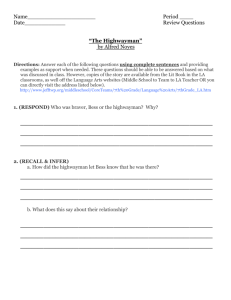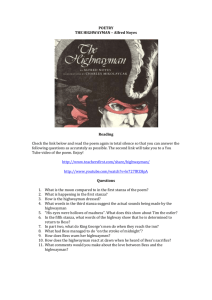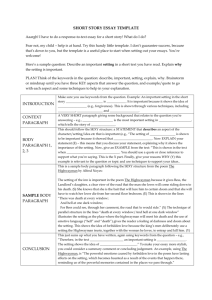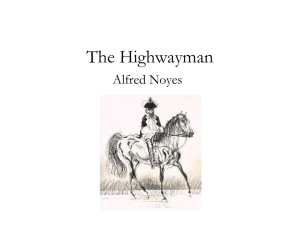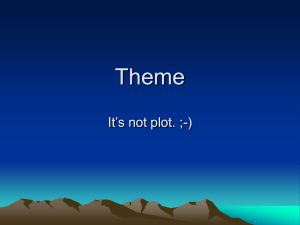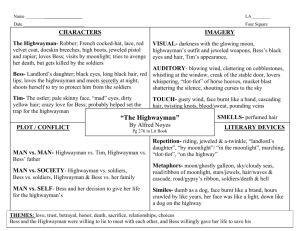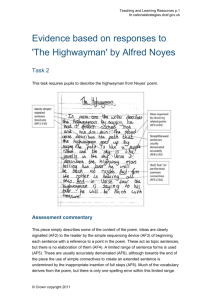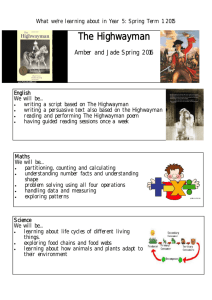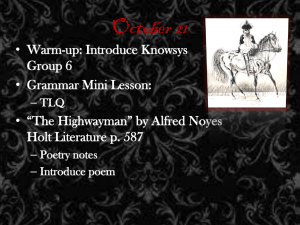Poem Summary
advertisement
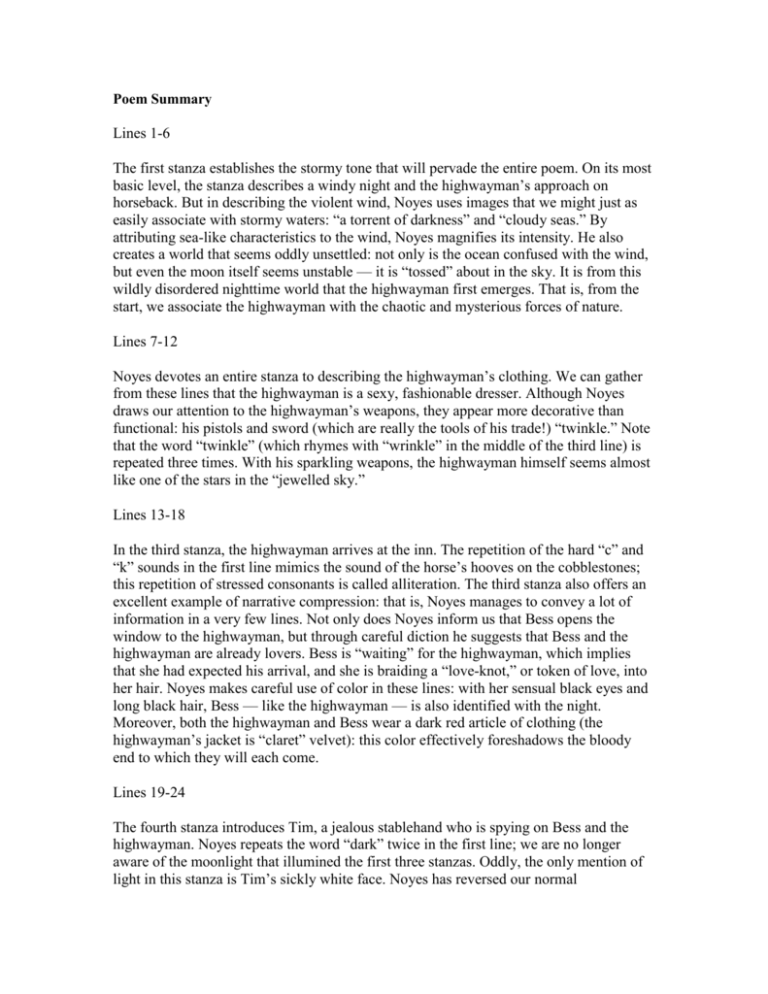
Poem Summary Lines 1-6 The first stanza establishes the stormy tone that will pervade the entire poem. On its most basic level, the stanza describes a windy night and the highwayman’s approach on horseback. But in describing the violent wind, Noyes uses images that we might just as easily associate with stormy waters: “a torrent of darkness” and “cloudy seas.” By attributing sea-like characteristics to the wind, Noyes magnifies its intensity. He also creates a world that seems oddly unsettled: not only is the ocean confused with the wind, but even the moon itself seems unstable — it is “tossed” about in the sky. It is from this wildly disordered nighttime world that the highwayman first emerges. That is, from the start, we associate the highwayman with the chaotic and mysterious forces of nature. Lines 7-12 Noyes devotes an entire stanza to describing the highwayman’s clothing. We can gather from these lines that the highwayman is a sexy, fashionable dresser. Although Noyes draws our attention to the highwayman’s weapons, they appear more decorative than functional: his pistols and sword (which are really the tools of his trade!) “twinkle.” Note that the word “twinkle” (which rhymes with “wrinkle” in the middle of the third line) is repeated three times. With his sparkling weapons, the highwayman himself seems almost like one of the stars in the “jewelled sky.” Lines 13-18 In the third stanza, the highwayman arrives at the inn. The repetition of the hard “c” and “k” sounds in the first line mimics the sound of the horse’s hooves on the cobblestones; this repetition of stressed consonants is called alliteration. The third stanza also offers an excellent example of narrative compression: that is, Noyes manages to convey a lot of information in a very few lines. Not only does Noyes inform us that Bess opens the window to the highwayman, but through careful diction he suggests that Bess and the highwayman are already lovers. Bess is “waiting” for the highwayman, which implies that she had expected his arrival, and she is braiding a “love-knot,” or token of love, into her hair. Noyes makes careful use of color in these lines: with her sensual black eyes and long black hair, Bess — like the highwayman — is also identified with the night. Moreover, both the highwayman and Bess wear a dark red article of clothing (the highwayman’s jacket is “claret” velvet): this color effectively foreshadows the bloody end to which they will each come. Lines 19-24 The fourth stanza introduces Tim, a jealous stablehand who is spying on Bess and the highwayman. Noyes repeats the word “dark” twice in the first line; we are no longer aware of the moonlight that illumined the first three stanzas. Oddly, the only mention of light in this stanza is Tim’s sickly white face. Noyes has reversed our normal expectations: usually, we associate the dark with evil and the light with good; here, however, the light seems dangerous and forbidding. Lines 25-30 Still underneath her window, the highwayman tells Bess about the robbery he plans to commit later that night (a conversation that Tim the ostler overhears). Noyes continues to establish the highwayman as a creature of the night: not only does the highwayman intend to return to Bess before daybreak, but his greatest concern is being pursued “through the day.” Notice the recurrence of the phrase “by moonlight” in the last three lines of the stanza. The first two instances occur in the two trimeter lines; the third occurs in the first half of the final hexameter line. By echoing the same three-stressed phrase three times, Noyes creates a climactic effect. This climactic build prepares us for the dramatic stanza which follows. Lines 31-36 This stanza concludes the first part of the poem. In it, the highwayman bids farewell to Bess and rides off to the west of England — probably toward Wales (where Noyes himself grew up). The description of their farewell is at once highly sensual and sexually charged. As Bess’s long hair spills over the highwayman’s face, we are told that it “burnt like a brand.” A brand is a tool used to burn an identifying mark in the flesh, and we have a sense here that, in parting, the two lovers have become permanently identified with each other. Notice, too, the recurrence of the water imagery that appeared in the first stanza. Bess’s hair is described as a “cascade,” or waterfall, and as having “waves.” By reinvoking this water imagery, Noyes links Bess to the stormy, windy night. At the end of Part One, then, Noyes has not only portrayed the passionate bond between the highwayman and Bess, but he has also associated both the lovers with the chaotic and dark night. Lines 37-42 The narrative resumes at sunset the following day; almost a full day has passed, but the highwayman has not yet returned. Instead, a whole troop of British soldiers appear, warned, no doubt, by Tim. Note the many ways in which this stanza echoes the very first stanza of the poem: the second lines of both stanzas mention the moon; the third lines describe the “road” as a “ribbon” on the “purple moor”; in the fourth, fifth, and sixth lines, a present participle verb, separated by dashes, is repeated four times (“riding” in the first stanza and “marching” here); and both stanzas conclude with the “old inn-door” being approached. The first stanza heralded the appearance of the highwayman. Given the way this stanza so closely echoes the first, we expect him to reappear. It is all the more disquieting, then, when in his place the red-coats appear. Lines 43-48 This stanza is extraordinarily violent. It begins with a violation of the landlord himself: the soldiers barge into the inn and take his ale. More important, the red-coats gag and tie up Bess — an action that is deliberately suggestive of sexual violence. Note the difference between the highwayman’s and the soldiers’ treatment of Bess. We would expect the soldiers (the representatives of the King) to be orderly and law-abiding and the highwayman (a criminal) to be cruel and uncaring. Exactly the opposite is true. Again we see Noyes reversing our expectations. Lines 49-54 The images of sexual violence and abuse become even more pronounced as the soldiers mock and then kiss Bess. They “tie her up to attention” with a gun pointed to her chest — a grotesque parody of a soldier. This stanza is remarkable for its sadistic overtones: given Noyes’s otherwise conservative attitudes toward the portrayal of sexuality and violence, one wonders why he would have written such a cruel scene. At best, we can say that the soldiers’ behavior serves as a useful contrast to the highwayman’s. Their repulsiveness makes us appreciate even more the purity of the highwayman’s love for Bess. (Note that in the third line the highwayman is described as “dead,” even though he has not yet been killed. For a moment, we see the situation through Bess’s eyes: to her, the highwayman’s death is so inevitable that she already thinks of him as dead.) Lines 56-61 Having recognized that the highwayman will certainly be killed if he reaches the inn, Bess attempts to warn him. She strains against the rope until she is able to reach the trigger. In describing this scene, Noyes uses a series of discordant, grating rhymes: “good” and “blood”; “midnight” and “it”; “years” and “hers.” “Good” and “blood” are called eye rhymes; the others are called off rhymes. All create a sense that something is, in fact, slightly “off” or wrong — no accident, considering the terribly wrong act of suicide that Bess is about to commit. Lines 62-67 The first line of this stanza echoes the last line of the previous stanza, reminding us that Bess only needs to be able to reach the trigger in order to kill herself. In the second line, we are told that Bess “stood up to attention,” an odd echo of line 49, which described the soldiers’ mocking treatment of her. In this context, however, the sense of the phrase is transformed: rather than being demeaned, Bess grows in nobility as she prepares to sacrifice herself for her lover. The reference to “blood” in the last line of the stanza warns us that Bess’s own blood will soon be spilled. This line also reminds us of the permanent bond between the two lovers: we are told the pulse of the blood in Bess’s veins “throbs” to the same beat as her lover’s “refrain.” It is not until the following stanza, however, that we are told what the highwayman’s “refrain” is. Lines 68-73 We are now told that the “refrain” is actually the sound of the highwayman’s horses’ hoofs (and in fact, the rhythm of a fast heartbeat can feel like the beat of horses’ hoofs). For the second time in the poem, we hear the highwayman approaching the inn. Noyes again uses the same formula that he used in the first stanza to describe the highwayman’s approach: the third line repeats the image of a “ribbon of moonlight”; and the fourth and fifth lines repeat the word “riding” three times. But here Noyes makes a notable change. In the first stanza, the word “riding” also appears in the final line: it signals the highwayman’s arrival at the inn door. In this stanza, Noyes substitutes the word “priming” for “riding.” This unexpected substitution drives home the idea that instead of arriving at the inn-door, the highwayman will meet the “primed” muskets of the soldiers. Lines 74-79 Just as the highwayman is about to be shot, Bess pulls the trigger and kills herself. Note, however, that the gun “shatters” not only Bess’s chest, but the “moonlight” itself. Because both Bess and the highwayman are so closely identified with the moonlight, Bess’s death seems to disrupt the entire night world. Note, moreover, the caesura, or break, in the last line of the stanza. Just as the moonlight has become shattered, or broken, the rhythm of the line itself has been shattered. Lines 80-85 The highwayman hears the gunshot and escapes, not realizing that Bess has killed herself. Notably, he does not learn the truth until the next morning — and daylight. Bess, he is told, “died in the darkness.” Her death signals an end to the mysterious and sensual nighttime world she and her lover had inhabited. Bess’s death thrusts the poem into the glaring light of day; Noyes’s diction underscores the unpleasant nature of the “whiteness” associated with the daylight hours. When the highwayman learns of Bess’s death, for instance, he “blanches,” or turns white, with dread. Lines 86-91 The imagery of this stanza reminds us that we are now indeed in the ugly daylight world dominated by the soldiers: no longer a “ribbon of moonlight,” the road is “white” and “smoking.” If the highwayman had governed the nighttime world, he is clearly out of his element in the daylight. With no trouble, the soldiers pursue and shoot him: he dies in the very “highway” he had once ruled. He has been reduced from the mysterious “highway man” to a “dog on the highway.” Lines 92-103 The final two stanzas repeat, almost word for word, the first and third stanzas of the poem. After the bloody carnage of Part Two, these lines take on added dimension. On one level, they bring us full circle to the beginning of the poem, reminding us of the pure love that Bess and the highwayman once shared. On another level, the repetition of these lines suggests that despite the carnage, the bond between the two lovers is so strong that even death cannot destroy it. In spirit — and in our imaginations — the renegade highwayman will forever be riding up the inn-door, where Bess will forever be there to welcome him. One is left to wonder then, where the victory lies: With the cruel and ugly powers of the day? Or with the mysterious forces of the night? http://www.dailymotion.com/video/x10mjd_fleetwood-mac-everywhere-1987_music Some call death "the ultimate sacrifice." What are some examples of people who have died to save others? What do you think were their reasons to give their lives? Allow students to volunteer responses and discuss. Explain that this is a poem about making a sacrifice. Tell students that in the eighteenth century, there were men who would ride the roads at night in search of wealthy people to rob. These men were called highwaymen. Have students read the poem aloud, then read the poem to them or play a recording of the poem. Ask and discuss the answers to the following questions: What is a metaphor? Can you find three of them in the first stanza? What is being compared in each one? How can wind be "a torrent of darkness?" How can the moon be "a ghostly galleon?" How can a road be "a ribbon of moonlight?" By using the words "torrent of darkness," "ghostly," and "moonlight," what kind of mood do you think Noyes is setting up for his poem? What is personification? Can you find the example of personification in stanza ten? What is being personified? Why do the hours seem to "crawl" for Bess at this point in the story? What is a simile? Can you find the simile in stanza thirteen? What two things are being compared? How can a face be "like a light?" What would cause Bess's face to be "like a light" as she stood listening to her love ride toward the inn? Review questions: In stanza twelve, there is an example of onomatopoeia. What is it? Why does Noyes make a sound effect rather than just tell us that the horse was galloping down the road? In stanza three, there is an example of alliteration. What is it? What is the repeated consonant sound? How do the words "cobbles," "clattered," and "clashed" create a sound effect for the action that is taking place in the stanza? Why do you think Noyes used "noisy words" at this point in the poem? Summary: "The Highwayman" Analysis Answer the following questions in your notes: 1. Choose to do one of the following: Explain in detail the plot of the story OR draw a plot mountain diagram that touches on key parts of the story. 2.Why do you think the author gave Bess dark hair and dark eyes, associating her with the night? 3. Explain how the highwayman is an outlaw and a hero. 4. What is Tim's role in the lovers' fate? 5. How is the soldiers' behaviour ironic? 6. Focus on figurative language: a. metaphor - How can a road be a "ribbon of moonlight"? List two other metaphors in the ballad. b. personification - Why do the hours seem to "crawl" for Bess in stanza ten? c. simile - What would cause Bess's face to be "like a light" in stanza thirteen? d. alliteration - In stanza three, why do you think the author chose to use the words "cobbles", "clattered", and "clashed"? 7. Why were the last two stanzas printed in italics? 8. Was Bess’s sacrifice worthwhile? Why or why not? 7. What is the theme of this poem? This should be a longer paragraph response that incorporates one to two quotes from the poem. "The Highwayman" Analysis (MODIFIED) Answer the following questions in your notes: 1. Think about the storyline of the highwayman. Fill in the following plot mountain diagram. 2.Do you think the highwayman is an outlaw or a hero? Why? ________________________________________________________________________ ________________________________________________________________________ ________________________________________________________________________ 3. In what way is it Tim’s fault that the lovers died? ________________________________________________________________________ ________________________________________________________________________ 4. Focus on figurative language: a. metaphor - How can a road be a "ribbon of moonlight"? __________________________________________________________________ __________________________________________________________________ b. personification - Why do the hours seem to "crawl" for Bess in stanza ten? __________________________________________________________________ __________________________________________________________________ 5. Do you feel that this poem has a happy ending or a sad ending? Why? _____________________________________________________________ _____________________________________________________________ _____________________________________________________________ Note-Taking Sheet for “The Highwayman” PART ONE “The Highwayman” by Alfred Noyes PART TWO
